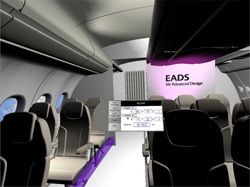Safer flights thanks to virtual reality
Simulations of reality on computers – i.e. virtual reality (VR) – have offered great support to the development of high-tech products and services. Yet the underlying technologies are still far from satisfying the real-life needs of aerospace industrial practice. The EU-funded Vision project is upgrading virtual reality for aerospace applications. The project is specifying and developing key interface features in VR technology, namely immersive visualisation and interaction, to improve flexibility, performance and cost efficiency. This particularly applies to critical aircraft-related virtual products such as the virtual cockpit and virtual cabin, making them more 'real' than ever. In more high-tech information technology (IT) terminology, the project involves specific human-oriented developments regarding simulations such as visual perception, real-time rendering, markerless body tracking and smart objects interaction. Vision is currently integrating these features within a common IT platform and validating them based on test cases that focus on specific aircraft-related virtual products. This will enable the launch of multidisciplinary activities around a virtual prototype that ensures human immersion in the desired context completely. Importantly, the technology will consider the simulation of different aspects of an aircraft's lifecycle (e.g. virtual assembly operations, cabin operations, tasks undertaken by crew or passengers). This will improve the human-oriented functionality and usage of these virtual products throughout their life cycle. Human factors and their implications in human-machine interaction within the aircraft-related products are also being considered in the definition of the technology specification framework. The project is expected to have significant impact on the creation of virtual aircraft products. The achievements of Vision are set to enhance credibility of aircraft-related VR simulations involving human interaction. They will improve aircraft-related virtual products to enable their use for increased design verification, validation of ergonomics and elaboration of specifications, as well as operational and situational training. Significant progress has been made on the technical side in developing the required features and software. Vision has already delivered concrete outputs that are fully aligned with its end users' interests. Analysis of requirements and project specifications have also been completed. Vision has delivered detailed visualisation/interaction technology specifications for virtual aircraft applications and human-factor guidelines required for development and implementation of the integration platform. These achievements plus Vision's ongoing developments promise the delivery of an advanced system that produces aircraft-related virtual reality simulations, facilitating training, enhancing security and testing new technology. This heralds an important step in the right direction for furthering safety and efficiency in the aeronautics industry.

